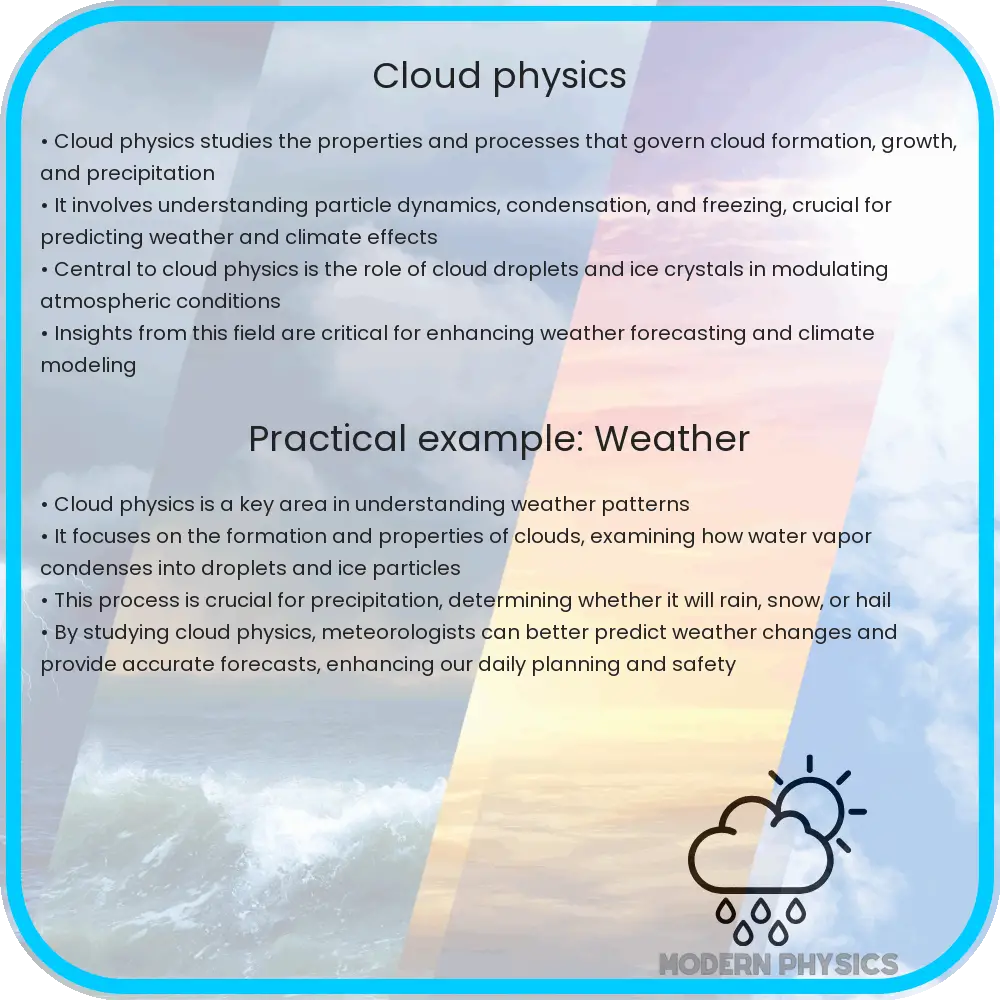Explore the fundamental principles of cloud physics, focusing on cloud formation, types, and their role in weather forecasting.

Understanding Cloud Physics: Atmospheric Insight and Weather Dynamics
Cloud physics is a branch of meteorology that focuses on the formation, composition, and dynamics of clouds. This field is crucial for enhancing our ability to predict weather patterns and understand the atmosphere’s role in Earth’s climate system. Let’s delve into the basics of cloud physics, exploring how clouds form, their types, and their impact on weather forecasting.
Formation of Clouds
Clouds form when the invisible water vapor in the air condenses into visible water droplets or ice crystals. The key process here is the condensation of water vapor or the deposition of ice, which occurs when moist air cools to its dew point—the temperature at which the air becomes saturated and cannot hold any more moisture.
There are several ways through which air can reach the dew point:
- Convection: Warm air rises naturally due to its lighter density compared to cooler air. As it rises, it expands and cools, potentially reaching the dew point.
- Orographic Lift: Air is forced upward by terrain such as mountains. As the air ascends the slope, it expands and cools.
- Convergence: When air flows come together from different directions, they are forced upward, leading to cooling and potential condensation.
- Frontal Systems: When warm and cold air masses meet, the warmer, lighter air is pushed over the colder, heavier air, again leading to cooling and condensation.
Each of these processes can lead to the formation of various cloud types, depending on factors like the amount of moisture in the air, the rate at which the air is cooling, and the atmospheric conditions present.
Types of Clouds and Their Classification
Clouds are classified into different types based on their shape, altitude, and the physical processes that create them. The World Meteorological Organization (WMO) categorizes clouds into ten basic types, often referred to as cloud genera. These can be grouped into three main levels of altitude:
- High-level clouds (Above 6,000 meters): Examples include Cirrus, Cirrostratus, and Cirrocumulus clouds. These are primarily composed of ice crystals due to the cold temperatures at these altitudes.
- Mid-level clouds (2,000 to 6,000 meters): Examples include Altostratus and Altocumulus clouds. These can be composed of water droplets, ice crystals, or a mixture of both, depending on the temperature.
- Low-level clouds (Below 2,000 meters): This category includes clouds like Stratus, Stratocumulus, and Nimbostratus. They are mostly composed of water droplets, but can also contain ice particles during colder conditions.
Understanding these cloud types and their characteristics helps meteorologists predict weather changes by observing cloud patterns and movements. For instance, the presence of Cirrostratus clouds often indicates that a change in the weather could occur within the next 24 hours, particularly signaling the approach of a warm front.
Clouds and Weather Prediction
Clouds play a pivotal role in weather prediction and the dynamics of the Earth’s atmosphere. By analyzing cloud formations, meteorologists can make educated guesses about upcoming weather events. Clouds affect the Earth’s energy balance and the hydrological cycle, influencing both local and global weather patterns.
Advanced technologies like satellite imaging and radar systems are used to study clouds from space and from within the atmosphere. These tools provide valuable data that helps in predicting weather conditions, enhancing our understanding of cloud physics, and eventually leading to improved accuracy in weather forecasting.
Impact of Clouds on Climate Change
Clouds also have a significant influence on climate change. They can act both as insulators and reflectors. Clouds trap heat and keep the planet warm, which is crucial during the night, but they can also reflect sunlight away from the Earth during the day, contributing to cooling. The net impact of clouds on Earth’s climate is complex and varies by cloud type, altitude, and geographical location.
Understanding the interaction between clouds and climate systems is essential for accurate climate modeling. By studying how clouds affect atmospheric temperatures and weather patterns, scientists can better predict the extent of global warming and propose effective strategies for climate mitigation.
Challenges in Cloud Physics
Despite the advances in technology and understanding, cloud physics remains a challenge for scientists. The main difficulty lies in the variability and transient nature of clouds. Predicting precisely when and where clouds will form and how they will impact weather and climate involves numerous variables. Each variable, from atmospheric pressure to local topography, plays a crucial role in cloud dynamics.
Additionally, the tools available, like satellites and radar, although sophisticated, have limitations in their predictive accuracy and resolution. Improved measurement techniques and more powerful computational models are continuously in development to enhance the precision of weather forecasting and climate predictions.
Education and Awareness in Cloud Physics
Education plays a critical role in the field of cloud physics. Increasing awareness and understanding of meteorological phenomena among the public and aspiring scientists is essential for the development of more sophisticated environmental technologies and approaches. This knowledge is also vital for preparing communities for severe weather events influenced by cloud formations.
Programs in schools, universities, and public awareness campaigns help demystify weather patterns and promote interest in atmospheric sciences, driving innovation and interest in tackling weather-related challenges.
Conclusion
Cloud physics is a dynamic field that bridges the gap between understanding atmospheric phenomena and practical weather prediction. From the clouds floating peacefully above us to more severe storm formations, every cloud has a story that impacts our weather, climate, and ultimately, our existence on Earth. By exploring the complexities of cloud formation, classification, and their role in climate systems, we gain valuable insights into the forces shaping our environment. As technology and knowledge advance, we can look forward to more precise weather forecasts and deeper understanding of our planet’s climate systems, ensuring better preparedness for future environmental challenges.
